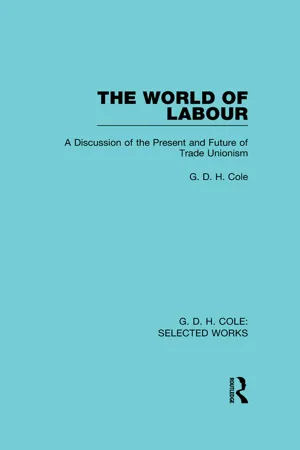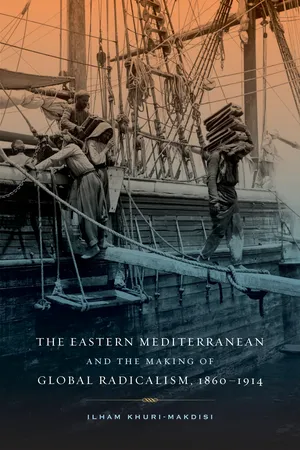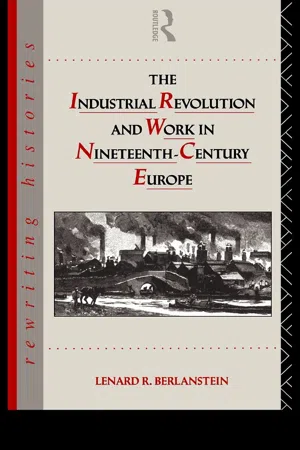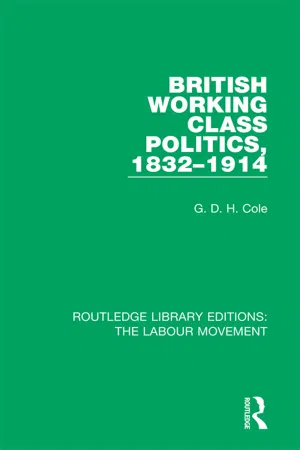History
Labor Unrest
Labor unrest refers to a period of time when workers were dissatisfied with their working conditions and wages, leading to strikes, protests, and other forms of collective action. This phenomenon was particularly prevalent during the Industrial Revolution, as workers sought to improve their living standards and gain greater control over their working lives.
Written by Perlego with AI-assistance
Related key terms
1 of 5
6 Key excerpts on "Labor Unrest"
- eBook - ePub
- G. Cole(Author)
- 2010(Publication Date)
- Taylor & Francis(Publisher)
Chapter IIThe Labour Unrest'UNREST ' is, as we have said, a vague term. It denotes in the first place a consciousness that all is not as it should be, and a dissatisfaction with present conditions; but it does not point to the possession of a panacea, to a widespread knowledge among the workers of what is necessary to remedy their grievances. Pure unrest is grievance without argument, dissatisfaction with the present without an ideal for the future. But though the very use of the word points to an absence of formulation and understanding by the worker of what he really wants, unrest could in fact find no possible outlet unless it in some measure materialised itself and asserted definite demands allowing of acceptance or refusal. The unrest therefore found determinate expression in the recent series of strikes, and will continue, as long as it remains, to find similar expression. In the strike a definite claim is made; and though there may be, behind the particular demand, a wider ideal and even a whole theory of social revolution, it is not necessary, for the purpose in hand, that this ideal background should be at all generally recognised. Every Labour movement will always have these two aspects: it will be at once a present claim for better conditions, and, in the minds of some at least of its advocates, an inroad on the present constitution of Society and an advance in the direction of social reconstruction.Clearly these two demands, the ideal and the immediate, may both be formulated in either of two ways. The one is Socialism, in the widest sense of the word: the other is Social Reform, in so far as it is a real modification of the society of the present. Both of these spirits, singly or together, may appear either in the industrial or in the political field. The Parliamentary Labour Party may be regarded as an ameliorative influence, a means of getting certain reforms out of Parliament; or, again, the Labour Party or an independent Socialist Party may be looked upon as the expression of the ideal aspirations of the workers, as the means of overthrowing capitalistic Society as a whole. Of course, the view usually and reasonably taken is a combination of these two views: neither revolutionism nor reformism is found in all its purity; but, broadly, these two conceptions of the function of Labour in Parliament stand in perpetual opposition. On the other hand, there has long been in France, and there is rapidly growing up in this country, a similar cleavage of opinion within the Trade Union movement itself. The older Unionism was purely an instrument of collective bargaining and mutual insurance, aiming at the realisation of 'a fair day's wage for a fair day's work' by progressive modifications of present conditions: but in face of this, there is now abroad in the Trade Unions a new spirit, whose motto is 'the abolition of the wage system', aiming at a Trade Union revolution and the reconstruction of society to some extent on an industrial basis. Within the Labour movement, Syndicalism, in the widest sense, and the old Unionism confront each other in the industrial field just as Social Democracy and Labourism are opposed in the sphere of politics. - Ilham Khuri-Makdisi(Author)
- 2010(Publication Date)
- University of California Press(Publisher)
Nor do these grievances explain the appeal and dissemination of radical leftist ideas of which labor militancy, and strikes in particular, are a form of praxis. Rather the adoption of strikes as a method of contestation reflects a series of significant changes and historical developments Workers and Labor Unrest 137 in the three cities, which can be summarized as follows: (1) the emergence of com-mon grievances and interests among workers in various sectors; (2) the weakening or disappearance of various institutions or groups that had previously defended workers’ rights; (3) local social flux that led to unstable labor categories and the ap-peal of radical ideas, while allowing workers in different sectors or geographic areas to establish new communication channels; and (4) global trends that transformed the cities under investigation into poles of attraction for global labor networks. In cities deeply integrated into the world capitalist system such as Alexandria, Cairo, and Beirut (and Mount Lebanon), few sectors of the economy were immune from fluctuations resulting from their incorporation into the world economy and subsequent encroachments by foreign companies. This was a new phenomenon that warranted new methods of contestation. Whereas in past centuries economic, po-litical, and social factors had occasionally triggered urban unrest, these factors had either concerned specific groups that rebelled and rioted—most commonly Janis-saries, but sometimes workers in certain guilds, such as butchers—or they had af-fected the entire urban population. In other words, such factors usually did not specifically or exclusively affect the entire labor force.- Lenard R. Berlanstein(Author)
- 2003(Publication Date)
- Routledge(Publisher)
Readers will have to decide whether they accept the conclusions Stearns draws from the strike profiles. In any case, the points he emphasizes, the incompleteness of labour mobilization and the diversity of workers’ experiences, have recently moved to the centre of scholarly concern. The final two readings approach these issues with new conceptual tools. * * * Substantial changes in work plus the limitations in developing compensations off the job explain much of the tide of protest that developed after 1890, a protest that had important precedents in earlier decades but which assumed massive and regular proportions in this period. The protest did not necessarily stem from rising discontent…. The protest of this period resulted partly from the availability of regular leadership and organization; workers in earlier stages of industrialization might have done as much or more, had these been at hand, just as their counterparts in Russia and Italy were attempting in these very years. But protest in western Europe had much to do with the changing work experience, and without surveying protest movements in great detail we must ask what the links were. Unfortunately, protest did not develop in a predictably close relationship to problems on the job. While recognizing the extensive unrest of the period and the deep roots that protest organizations were taking within the working class, we must emerge with an impression of its tangential bearing on the work question. Put simply, protest did not directly convey the most basic complaints workers had about their jobs or the anguish that some of them felt at work. There were good reasons for this, which we will explore, but the gap between what might have been sought and what was sought remained potentially tragic…. It can readily be agreed that strikes and some trade union activities constituted the most direct means of protest against job grievances.- eBook - ePub
The Homestead Strike
Labor, Violence, and American Industry
- Paul Kahan(Author)
- 2014(Publication Date)
- Routledge(Publisher)
The history of American labor unionism has been shaped by at least two themes. First is that American unionism did not grow in a vacuum. Unions’ success at negotiating on behalf of their members was heavily dependent upon the economic climate in which those negotiations were taking place. America’s economy during the nineteenth century was characterized by a cycle of fantastic booms and catastrophic busts. When times were good, labor was in short supply, and labor unions were generally successful in achieving their goals. When the economy slid into recession (or even depression, as it did in 1819, 1837, 1857, 1873, and 1882), there were more workers than jobs, which weakened (and, in many cases, destroyed) many American unions. Nonetheless, while the story of American labor organization follows a “roller coaster” trajectory (steep climbs followed by breakneck descents), overall unions achieved some important victories during the nineteenth century that placed them at the center of labor negotiations in the United States.A second theme is related to the first. As labor unions grew in importance in the American labor market, employers began mobilizing the state’s legal and military resources to weaken these organizations. By the 1870s, the struggles between employers and employees became larger, more frequent, and more violent, a direct result of employers’ growing use of state military power (i.e., militias) or private police forces such as the Pinkertons to break strikes and protect replacement workers. The last three decades of the nineteenth century saw some of the largest and most violent labor clashes in American history, including the Railroad Strike of 1877, the Haymarket Riot of 1886, and the Homestead Strike of 1892. While each of these events is important in its own right, it is important to see them not as discrete episodes, but as a chain of linked events forged by the changing economic, political, and social circumstances that both fueled the rise of labor unionism and led to violent clashes between employers and their employees.Prior to the 1840s, workers expressed their dissatisfaction not by striking, but with periodic riots that would sweep through cities. These outbreaks of violence were usually about more than just wages or working conditions; food prices, local politics, abolitionist meetings, and other non-work issues could incite riots. Furthermore, these riots were not isolated to a specific employer or industry, and depending on the issue, employers would sometimes riot alongside their workers.1 - eBook - ePub
- G. D. H. Cole(Author)
- 2018(Publication Date)
- Taylor & Francis(Publisher)
CHAPTER XVIITHE LABOUR UNREST
The National Insurance Act—The Irish Crisis—Syndicalism and the Servile StateT HE years between 1911 and 1914 were a period of sharp and continuous industrial unrest. By 1910 trade had recovered from the depression of the two previous years, and by 1911 employment was expanding rapidly. Wage-rates, however, continued to lag seriously behind the rising cost of living. Food prices were about 9 per cent higher in 1910 and 1911 than in 1900, whereas wage-rates were no higher at all. In view of the rapidly expanding prosperity of industry, it was natural that such a situation should give rise to serious discontent.It would, however, be an error to attribute the unrest of the years before the Great War exclusively to the fall in real wages. There were undoubtedly other forces at work. The Trade Unions had secured under the Trade Disputes Act of 1906 the restoration of the right to strike, which had been practically abrogated by the Taff Vale Judgment; but the depression of 1908 and 1909 had allowed little opportunity of making use of the restored power. Consequently, when trade began to boom, there was an accumulation of working-class grievances, by no means only over wages, waiting to be put right; and in fact many of the disputes of the next few years were not about wages, but about such matters as the recognition of collective bargaining, or the removal of various forms of workshop tyranny which the workers at last felt strong enough to resist.Even this is by no means the complete explanation. For the unrest of these years was not confined to the working classes. Indeed, its most spectacular manifestation was the outbreak of militancy on the part of the suffragettes, headed by Emmeline and Christabel Pankhurst. Mrs. Pankhurst had founded the Women’s Social and Political Union at Manchester in 1903; and from the autumn of 1905 this body adopted a policy of increasing militancy, beginning with the systematic howling down of speakers, especially Liberals, at public meetings and developing later into widespread sabotage by the firing of pillar-boxes and buildings, and into mass conflicts with the police in attempted raids on such places as Downing Street and the House of Commons. The demand of the militants, who were at war with the constitutional wing of the suffrage movement as well as with the Liberal Government, was that every other issue should be put aside until the women had been given the vote; and the Labour Party, because most of its leaders refused to accept this view, came in for a share of the attentions of the Pankhursts and their followers. Keir Hardie and, a little later, George Lansbury worked hard for the militants, until even they were estranged by the personal dictatorship assumed by Mrs. Pankhurst and her daughter. Under stress of this dictatorship, the militant movement split again and again. The W.S.P.U. had at the outset been fairly close to the I.L.P., of which Mrs. Pankhurst and her husband had been leading members from the beginning; but as the women’s crusade developed the W.S.P.U. came to be more and more a middle- and even upper-class body of fanatical followers of the Pankhursts, who drifted right out of the Labour movement and became increasingly hostile to it. The Pethick Lawrences, Mrs. Despard, and Christabel’s sister, Sylvia Pankhurst, were among those who broke away from the W.S.P.U. to create new movements, also militant, but repudiating the peculiar tactics of Mrs. Pankhurst and her favourite daughter; and these dissident sections of the suffrage organization remained in close touch with Labour. But they too were strongly critical of the lukewarm support given to the women’s cause by Ramsay MacDonald and the official leadership of the party; and it was in protest against the official attitude that, in the autumn of 1912, George Lansbury insisted on resigning his seat at Bow and Bromley, and fighting it again on the suffrage issue. He was beaten, by 751, in a straight fight with a Tory; and only his great personal popularity saved him from a much worse defeat, for by that time the indiscriminate policy of the W.S.P.U. had brought the tactics of the militants into disfavour with the main body of the public. - Jie Shen(Author)
- 2007(Publication Date)
- Chandos Publishing(Publisher)
In spite of facing retaliation from employers, such as losing jobs or work unit housing, or even criminal charges, desperate workers have no other choice but to fight for justice. Their struggles are reflected in many forms, from appealing to unions and local government, work stoppages and strikes. Other more violent collective actions are emerging, such as street demonstrations and protests, blocking main roads and government buildings, beating up enterprise managers and smashing or sabotaging enterprise properties. At the beginning of the economic reform, workers were reluctant to act in this way. Gradually, discontented workers have become more prepared to do so. Workers have also proved adept at using the proletarian rhetoric of the Maoist period to press for social justice in the new economic environment and phrasing their demands in class terms, which the authorities find uncomfortable to deal with (Chen, 1995; Sheehan, 1998). The widespread labour disputes are a major source of social instability, which is perceived by the CCP as the major threat to its nearly six decade-long rule in China. With employment relations becoming more complex, labour disputes become more equally complex in terms of their forms and causes, making it increasingly difficult for the CCP to solve. This chapter discusses the characteristics of labour disputes in China by looking at a selection of labour dispute issues, including their growth, 1 Labour-Management Reporting and Disclosure Act of 1959, http://www.dol.gov/esa/regs/statutes/olms/lmrda.htm, accessed 26 February 2006. 46 regional difference, collective disputes, major direct causes and the impact of economic ownership on labour disputes. The growth of labour disputes As employment relations have become diversified and complicated, the number of labour dispute cases in China has risen sharply since the economic reform.
Index pages curate the most relevant extracts from our library of academic textbooks. They’ve been created using an in-house natural language model (NLM), each adding context and meaning to key research topics.





